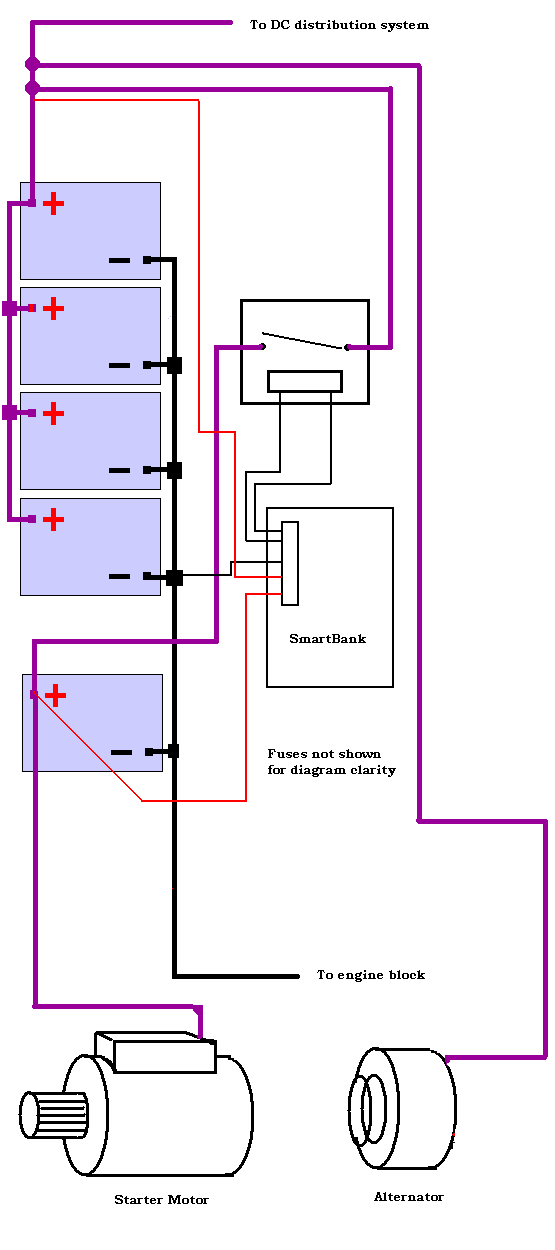Choosing your DC charging and split charging system.
One disadvantage with the system evolved so far is that if the engine is started with the domestic battery isolator switched off it could damage the alternator. Alternators do not like to be run with no load. It can cause excessively high voltages which can damage the alternator rectifier diodes and any other fragile equipment connected to the alternator output.
A simple solution to this is to feed the power to the ignition switch from the domestic battery instead of from the engine start battery. This means that the engine cannot be started unless both isolator switches are on. A slight disadvantage in this idea is that the domestic battery must not be flat otherwise the engine will not start. However it only has to provide a small amount of power to energise the starter relay. If the domestic battery is so flat that it cannot do this then the fact that the engine cannot be started might be the least of your problems. However if it does come to this, then simply connecting both battery positives together will allow the engine to be started. This could be done either with a jump lead or, preferably, by installing a battery isolator switch between the two battery positives. This emergency parallel switch is a very good idea anyway.
We now have a system that charges, efficiently, both batteries from the single engine alternator. But there are still one or two problems that need to be tackled.
Firstly, if a very heavy load is placed on the domestic bank that exceeds the capability of the alternator, this will also discharge the engine start battery. Obviously this is not good.
Some modern alternators (particularly on modern vehicles) do not have the D+ or Ind terminal therefore there is no way to energise the relay.
Any other form of single output charger such as a small AC powered charger, inverter/charger combi, wind turbine or solar panel etc, cannot charge the engine start battery. It would be much better if they could. Batteries self discharge if left to their own devices and a boat left unattented with no charge on the engine start battery could easily end up with a flat battery after a few months.
How can these problems be tackled?
The easiest way is with a SmartBank. This is a relay based split charge system that removes these problems as well as all the problems that exist with split charge diodes.
How?
It is a "lossless" split charge system. This means it doesn't suffer from the huge voltage drops associated with split charge diodes.
It isn't controlled by the D+ or Ind terminal on the alternator, therefore it can be installed in systems that do not have this terminal.
As it isn't controlled by the D+ or Ind terminal, if a heavy load that exceeds the alternator capability is placed on the domestic bank, SmartBank will separate the engine battery until the load is removed thus preventing flattening of the engine start battery.
No modifications are required to the existing installation. SmartBank is merely added to what is already there. This makes installation much simpler and also means the addition of SmartBank cannot affect the warranty of the existing installation. This simply cannot be said of split charge diodes where the existing cabling has to be modifed.
With the addition of a simple light duty switch SmartBank incorporates the emergency parallel feature to enable all batteries to be connected together for emergency engine starting. Details are in the technical section.
And so here is the installation with a SmartBank installed. You can instantly see just how simple the installation is considering it solves all the many problems of the various other split charge systems.
From SmartBank there are two wires to control the relay coil, a ground wire, and a wire to each of the battery positive posts. There is no need to modify any of the existing installation and the final result is a split charge system that operates whatever charge source is used and does not suffer the many losses introduced by split charge diodes.

At the time of writing this split charge system simply cannot be improved upon.
Page last updated 02/04/2008.
Website best viewed on a computer of some sort.